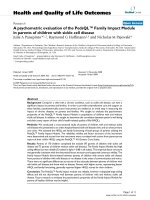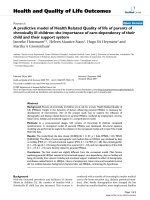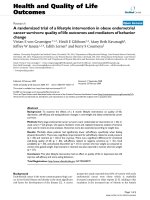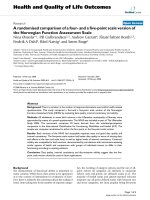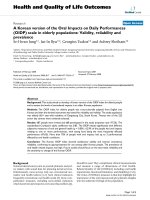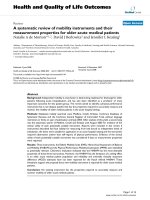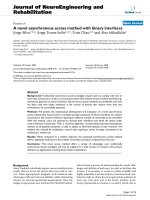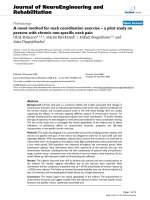báo cáo hóa học:" A novel role of HLA class I in the pathology of medulloblastoma" docx
Bạn đang xem bản rút gọn của tài liệu. Xem và tải ngay bản đầy đủ của tài liệu tại đây (2.86 MB, 13 trang )
BioMed Central
Page 1 of 13
(page number not for citation purposes)
Journal of Translational Medicine
Open Access
Research
A novel role of HLA class I in the pathology of medulloblastoma
Courtney Smith
1,3
, Mariarita Santi
2
, Bhargavi Rajan
1
, Elisabeth J Rushing
4
,
Mi Rim Choi
1
, Brian R Rood
1,3
, Robert Cornelison
5
, Tobey J MacDonald
1,3
and Stanislav Vukmanovic*
1,3
Address:
1
Center for Cancer and Immunology Research, Children's Research Institute, Children's National Medical Center, 111 Michigan Avenue
NW, Washington, DC, USA,
2
Department of Pathology, Children's National Medical Center, 111 Michigan Avenue NW, Washington, DC, USA,
3
Department of Pediatrics, George Washington University School of Medicine, Washington, DC, USA,
4
Department of Neuropathology, Armed
Forces Institute of Pathology, Washington, DC, USA and
5
Cancer Genetics Branch, National Human Genome Research Institute, NIH, Bethesda,
Maryland, USA
Email: Courtney Smith - ; Mariarita Santi - ; Bhargavi Rajan - ;
Elisabeth J Rushing - ; Mi Rim Choi - ; Brian R Rood - ;
Robert Cornelison - ; Tobey J MacDonald - ; Stanislav Vukmanovic* -
* Corresponding author
Abstract
Background: MHC class I expression by cancer cells enables specific antigen recognition by the
immune system and protection of the host. However, in some cancer types MHC class I expression
is associated with an unfavorable outcome. We explored the basis of MHC class I association with
unfavorable prognostic marker expression in the case of medulloblastoma.
Methods: We investigated expression of four essential components of MHC class I (heavy chain,
β2m, TAP1 and TAP2) in 10 medulloblastoma mRNA samples, a tissue microarray containing 139
medulloblastoma tissues and 3 medulloblastoma cell lines. Further, in medulloblastoma cell lines we
evaluated the effects of HLA class I engagement on activation of ERK1/2 and migration in vitro.
Results: The majority of specimens displayed undetectable or low levels of the heavy chains.
Medulloblastomas expressing high levels of HLA class I displayed significantly higher levels of
anaplasia and c-myc expression, markers of poor prognosis. Binding of β2m or a specific antibody
to open forms of HLA class I promoted phosphorylation of ERK1/2 in medulloblastoma cell line
with high levels, but not in the cell line with low levels of HLA heavy chain. This treatment also
promoted ERK1/2 activation dependent migration of medulloblastoma cells.
Conclusion: MHC class I expression in medulloblastoma is associated with anaplasia and c-myc
expression, markers of poor prognosis. Peptide- and/or β2m-free forms of MHC class I may
contribute to a more malignant phenotype of medulloblastoma by modulating activation of signaling
molecules such as ERK1/2 that stimulates cell mobility.
Introduction
The host immune system can be harnessed for the treat-
ment of tumors because of the ability of T lymphocytes to
specifically recognize tumor-associated antigens. CD8
+
T
cells destroy tumor cells by perforin-dependent cytotoxic
action, following recognition of MHC class I (HLA in
Published: 12 July 2009
Journal of Translational Medicine 2009, 7:59 doi:10.1186/1479-5876-7-59
Received: 19 March 2009
Accepted: 12 July 2009
This article is available from: />© 2009 Smith et al; licensee BioMed Central Ltd.
This is an Open Access article distributed under the terms of the Creative Commons Attribution License ( />),
which permits unrestricted use, distribution, and reproduction in any medium, provided the original work is properly cited.
Journal of Translational Medicine 2009, 7:59 />Page 2 of 13
(page number not for citation purposes)
humans) molecules at the cell surface [1]. Structurally, the
MHC class I molecule is comprised of a 44-kD heavy
chain, β2-microglobulin (β2m), and a peptide of 8–10
amino acid residues [2-4]. Presentation of antigenic pep-
tides by MHC class I requires processing involving protea-
some-mediated peptide generation from cytosolic
proteins, peptide transport into the ER mediated by trans-
porter associated with antigen processing (TAP), and pep-
tide assembly with the heavy chain/β2m heterodimer
[3,4]. TAP is a member of the ATP-binding cassette (ABC)-
family of transporters and consists of the TAP1 and TAP2
subunits [3,5,6]. Although additional molecules are
involved in assembly of MHC class I molecules, the heavy
chain, β2m, TAP1 and TAP2 are especially important for
functional expression of MHC class I and peptide presen-
tation as deletion of any one of these four molecules
results in a profound loss of cell surface expression [3,4].
Loss of MHC class I by tumor cells is thought to represent
evasion of tumors from recognition by tumor-specific
CD8
+
T cells [7,8]. Consistent with this notion, loss of
MHC class I in cancers such as small cell lung carcinoma,
pancreatic carcinoma, cervical cancer, colon cancer and
melanoma is a negative prognostic factor [9-12]. In a care-
fully designed study, HLA class I expression was shown to
dramatically decrease in secondary, relative to the primary
lesions of breast carcinoma [13]. In another example
involving glioma, loss of HLA expression was observed
preferentially along the periphery of tumor samples, sug-
gesting that this represents a stealth strategy that facilitates
more aggressive tumor expansion [14]. However, a com-
pletely opposite correlation was observed in non-small
cell lung cancer, uveal melanoma and breast carcinoma,
where increased survival occurred in MHC class I negative
tumors [15-17]. Interestingly, both positive (HLA-loss)
and negative (HLA-down modulation) associations with
the outcome of colorectal cancer have been observed in
the same study [18]. The reasons for this counter-intuitive
effect of MHC class I expression remain elusive.
Besides intercellular interactions, MHC class I molecules
have also been implicated in cis modification of signal
transduction. Heavy chains dissociated from β2m and
peptides (called open conformers), and not the fully
assembled MHC class I molecules, associate with a
number of cell surface receptors, resulting in modulation
of their activation [19]. Interestingly, addition of β2m,
which reduces the proportion of open conformers,
appears to either reduce [20] or enhance [21-24] signal
transduction in different experimental systems. Thus, the
direction of signaling modulation by MHC class I open
conformers most likely depends on the identity of the
associated receptor and can be manipulated by exogenous
addition of β2m. Increased serum levels of β2m were
found in several types of cancer [25-32] and were estab-
lished as a poor prognostic factor in bronchial carcinoma
[26], Hodgkin's lymphoma [27], multiple myeloma [31],
renal cell carcinoma [29] and prostate carcinoma [32]. At
present, it is unclear whether the effects of β2m are medi-
ated through HLA class I.
Medulloblastoma is the most common pediatric central
nervous system malignancy accounting for 30% of all
pediatric brain tumors, with the highest prevalence
between the ages of three and eight years [33,34]. Medul-
loblastoma has the tendency to disseminate throughout
the central nervous system early in the course of the dis-
ease. The levels of β2m mRNA are significantly higher in
metastatic than in non-metastatic forms of medulloblast-
oma [35], suggesting a potential association of β2m and/
or HLA class I with aggressive behavior and poor progno-
sis in this type of tumor, as well. Invasiveness in medul-
loblastoma is mediated by several receptor activation
pathways, such as platelet derived growth factor receptor
and epidermal growth factor receptor [36]. Common
components of these, as well as some other signaling
pathways are ERK1/2 and AKT kinases. We show in this
manuscript that a small fraction of medulloblastomas
express high levels of MHC class I and that markers of
poor prognosis are represented disproportionately more
in specimens with high MHC class I expression. Further-
more, HLA class I may be involved in signaling modifica-
tion as exogenously added β2m binds to HLA class I and
enhances activation of ERK1/2 that, in turn, affects the
mobility of medulloblastoma cells.
Methods
Generation of Tissue Microarray
Medulloblastoma tissue microarrays were generated as
previously described [37]. Formalin-fixed, paraffin
embedded tissue blocks were obtained from both the
Armed Forces Institute of Pathology and Children's
National Medical Center. More than 95% of tissues were
obtained for diagnostic purposes, hence patients under-
went no prior therapy. A neuropathologist (MS) marked
two representative tumor core regions within each tissue
block. The cores measuring 0.6 mm in diameter and 3–4
mm in height were isolated. A de-identified microarray
was generated using 4–8 μm sections cut from the core
blocks including: 139 medulloblastomas (47 classic, 40
anaplastic, 25 desmoplastic and 27 with unclassified his-
tology), 21 primitive neuroectodermal tumors, 10 small
cell carcinomas, 5 atypical teratoid rhabdoid tumors, 3
oat cell lung carcinomas, one each of ependymoblastoma
and lymphoma, and 20 tissues of brain metastases from
tumors of various origin. IRB approval was obtained for
the construction and analysis of these tissue microarrays
and all other tumor specimens investigated.
Journal of Translational Medicine 2009, 7:59 />Page 3 of 13
(page number not for citation purposes)
Cell Lines
DAOY, D283 and D556 medulloblastoma cell lines were
maintained at 37°C in a humidified atmosphere contain-
ing 5% CO
2
in RPMI media supplemented with 10% Fetal
bovine serum, 2 mM L-glutamine, 1 mM 2-mercaptoetha-
nol, 100 U/ml penicillin and 100 μg/ml streptomycin.
Antibodies
Polyclonal rabbit anti-human β2m and monoclonal
mouse anti-human CD45 (clones 2B11 + PD7/26) were
purchased from DakoCytomation, Carpinteria, CA. The
hybridoma secreting HC-10 antibody, specific for HLA
heavy chain epitope revealed in the absence of β2m and
peptide [38], was kindly provided by Dr. Pan Zheng (Uni-
versity of Michigan School of Medicine, Ann Arbor, MI).
Anti- TAP1 (NOB-1) and TAP2 (NOB-2) antibodies [39]
were provided by Dr. S. Ferrone (Hillman Cancer Center,
University of Pittsburgh Cancer Institute, Pittsburgh, PA).
The W6/32 monoclonal antibody is specific for HLA A, B
and C and specifically to the combined epitope contrib-
uted by the α2 and α3 domains of the heavy chain and
β2m [40-42]. mAb rabbit anti-human GAPDH, rabbit
anti-human phospho-p44/p42 MAP kinase (Thr202/
Tyr204), mAb rabbit anti-human p44/p42 MAP kinase,
rabbit anti-human phospho-AKT (Ser473), rabbit anti-
human AKT, mAb mouse anti-human phospho-EGF
receptor (Tyr1068), rabbit anti-human EGF receptor, rab-
bit anti-human phospho-PDGFRβ (Tyr751) were pur-
chased from Cell Signaling (Beverly, MA), anti-c-myc
from Abcam (Cambridge, MA), rabbit anti-human
PDGFR- β (Santa Cruz) and anti-rabbit IgG HRP-linked
antibody (Cell Signaling). HC-10 and W6/32 antibodies
were partially purified from hybridoma supernatants
using the centriplus YM-100 (Millipore) regenerated cel-
lulose filters that have a molecular weight cutoff of
100,000 Da. Antibody concentration after purification
was 2 mg/ml.
Immunohistochemistry (IHC)
Slides containing tissue arrays were deparaffinized and
rehydrated. The primary Abs HC-10, TAP1 and TAP2
required an additional heat-induced epitope retrieval step
(Target Retrieval Solution pH 9 or Target Retrieval Solu-
tion, pH6.1, DakoCytomation, Carpinteria, CA). Slides
were blocked with biotin (Biotin Blocking System, Dako-
Cytomation) and processed using the 3-step streptavidin-
biotin-immunoperoxidase staining system (LSABTM2+
System-HRP, DakoCytomation, Carpinteria, CA). Diami-
nobenzidine (DAB) was the chromogenic substrate. May-
ers hematoxylin was used as a counterstain and followed
with an ammonia wash. Slides were mounted using an
aqueous mounting medium (Faramount, DakoCytoma-
tion). Controls consisted of parallel sections without pri-
mary antibody. Stainings for heavy chain, β2m, TAP1,
TAP2 and CD45 were assigned scores of 0–3 [43] based
on the percentage of stained cells (0- no staining; 1- less
than 10% cells stained; 2- 10–50% cells stained; 3- >50%
cells positive). The staining for c-myc was not restricted to
particular cells, but was rather present or absent through-
out the tumor. Hence, c-myc scores were assigned 0
(absent staining), 1 (weak diffuse staining) or 2 (strong
diffuse staining). Each score was an average of the two
samples graded for each individual tumor in the array.
Each slide was evaluated by three independent graders
including two neuropathologists. The images were
acquired using the following equipment: Microscope –
Carl Zeiss Axioskop; Lenses- Achroplan 40× and Achrop-
lan 20×; Camera – Carl Zeiss Axio Cam HRC; Acquisition
software- Axio Vision Rel. 4.3.
Flow Cytometry
Cells were incubated with either 5% FBS in PBS (controls)
or W6/32 or HC-10 supernatant for 1 hour. After 3 rinses,
cells were incubated with PE labeled donkey anti-mouse
IgG (H+L) (eBiosciences, San Diego, CA) for 30 minutes
at 4°C. Cells were rinsed 3 times and fixed in cytofix (BD
Sciences, San Diego, CA).
RT-PCR
Total cellular RNA, obtained from 10 frozen medulloblas-
toma specimens, was subjected to the SuperScript First-
strand synthesis system for RT-PCR (Invitrogen, Carlsbad,
CA) to generate the cDNA for the PCR reactions. RT-PCR
were performed using 35 cycles of 30 seconds at 94°C, 1
minute at the annealing temperature, and 1 minute at
72°C (with the exception for HLA-A and HLA-B where the
last cycle was for 1 minute 30 seconds at 72°C). The
annealing temperatures were 57°C for TAP2 and β2m,
58°C for β-actin and CD45, 59°C for TAP1 and 60°C for
HLA-A and HLA-B. The primer sequences were: 5'-GAGA-
CATCTTGGAACTGGAC-3' and 5'-CTCTGAGTGA-
GAATCTGAGC-3' (forward and reverse, TAP1), 5'-
GTACAACACCCGCCATCAG-3' and 5'-GGACGTAGGG-
TAAACGTCAGC-3' (TAP2), 5'-CTCGCGCTACTCTCTCTT-
3' and 5'-AAGACCAGTCCTTGCTGA-3' (β2m), 5'-TAT-
AGTCGACCACCCGGACTCAGAATCTCCT-3' and 5'-
ATATGGATCCATCTCAGTCCCTCACAAGA-3' (HLA-A),
5'-TATAGTCGACCACCCGGACTCAGAGTCTCCT-3' and
5'-ATATGGATCCATCTCAGTCCCTCACAAGA-3' (HLA-
B), 5'-ACCTGTACGCCAACACAGTG-3' and 5'-GCCAT-
GCCAATCTCATCTT-3' (β-Actin), 5'-CTGAAGGAGAC-
CATTGGTGA and 5'-GGTACTGGTACACAGTTCGA-3'
(CD45). The reactions were loaded onto a 1% agarose gel
and products were visualized by ethidium bromide stain-
ing.
Western Blotting
DAOY and D283 cells were cultured in serum-free media
for 24 hrs at 37°C. Cells were washed twice and treated
with serum-free RPMI with or without human β2m (Lee
Journal of Translational Medicine 2009, 7:59 />Page 4 of 13
(page number not for citation purposes)
Biosolutions, Inc, St. Louis, Missouri) or monoclonal
antibodies for indicated times, at 37°C. Signaling was
halted by the addition of ice cold PBS and cells were lysed
with 1× cell lysis buffer (Cell Signaling, Danvers, Massa-
chussetts) supplemented with PhosSTOP phosphatase
inhibitor cocktail and complete mini protease inhibitor
cocktail (Roche, Indianapolis, Indiana). Lysates were cen-
trifuged at 14,000 rpm for 15 minutes to remove cell
debris, boiled for 5 minutes in loading buffer and sepa-
rated by a 4–12% Bis-Tris Gel (Invitrogen, Carlsbad, Cali-
fornia). Membranes were blocked in 5% milk in TBST for
1 hour at room temperature. Primary and secondary anti-
bodies were diluted in 3% BSA in TBST and incubated
with the membrane at 4°C overnight and at room temper-
ature for 1 hour, respectively. Signal was detected using
the enhanced chemiluminescence system (Pierce, Rock-
ford, IL). Densitometry quantification of the bands was
performed using Quantity One software (Bio-Rad, Her-
cules, CA), according to manufacturer's instructions. The
Band 1/Band 2 ratio was obtained by dividing differences
between intensity units observed in the square areas con-
taining specific bands and an identical blank area drawn
in the immediate vicinity of the band, according to the
following formula: Band 1/Band 2 ratio= (Band 1-blank)/
(Band 2 -blank).
Wound scratch assay
Wound scratch assay was used to evaluate tumor cell
migration [44,45]. DAOY cells were plated in a 60 mm
dish at 40% confluency and grown overnight. After 24
hours the cells were scraped down the middle of the plate
with a 200 μl pipette tip to induce the resemblance of a
wound and washed twice with serum-free media. Cells
were cultured with serum free media with or without 2 μg/
ml β2m for 24 hours. Images of the wound were taken at
0 and 24 hours. The area of the wound was calculated
using the Axiovision system by tracing the cleared space.
Area was measured in μM2. The ratio of 24 hours to 0
hours was calculated for each sample.
Results
Medulloblastoma expression of MHC class I antigen
Expression of MHC class I in medulloblastoma has been
reported in two studies with conflicting results [46,47].
We therefore examined the MHC class I expression in our
collection of medulloblastoma specimens. The expression
of the essential components of the MHC class I antigen-
processing machinery: HLA heavy chains (A and B), β2m,
TAP1 and TAP2 was first evaluated using RNA from ten
frozen medulloblastoma specimens. β2m was expressed
in all samples, while heavy chains and TAP subunits were
detected in seven samples (Fig. 1A). An essential element
of this analysis was the assignment of MHC class I expres-
sion to the tumor cells and not to the leukocytes infiltrat-
ing the medulloblastoma tissues. CD45 detection was
used to evaluate contamination by leukocyte-derived
RNA. CD45 was undetectable in four samples. Three of
the CD45-negative samples (M66, M63 and M68)
expressed β2m and not the other three components, indi-
cating that the majority of medulloblastomas fail to
express MHC class I. The fourth sample (M69) expressed
all four components.
Because of relatively frequent leukocyte infiltration, the
ability to discriminate RNA from tumor versus stromal
host cells was low in many medulloblastoma samples.
IHC analysis of medulloblastoma tissues is advantageous
in this respect, because areas of leukocyte infiltration and
MHC class I expression can be directly visualized and
compared to tumor cell expression in each individual
sample. We therefore analyzed HLA heavy chains, β2m,
TAP1, TAP2 and CD45 intracellular and/or cell surface
expression using medulloblastoma tissue microarrays.
Representative staining patterns for HLA heavy chains are
shown in Fig. 1B. Of the 106 evaluable specimens 87%
showed absent or faint heavy chain positivity (56% scored
0 and 31% scored 1), while scores 2 and 3 were observed
in 5% and 8% of tissues, respectively (Table 1). To gain a
better molecular understanding of MHC class I expres-
sion, medulloblastoma arrays were stained with antibod-
ies to TAP subunits and β2m (Table 1). In agreement with
the mRNA analysis, the majority of medulloblastoma tis-
sues expressed high levels of β2m protein. Surprisingly,
similarly high levels of TAP1 were seen, while staining of
TAP2 was intermediate (Table 1). The 14 samples with
scores 2 or 3 for staining with HC-10 antibody also dis-
played high levels of TAP1, TAP2 and β2m (except for
TAP2 in two samples). Therefore, we conclude that there
is a small subset of medulloblastomas that may express all
components required for functional MHC class I mole-
cules, whereas at least one essential component (heavy
chain or TAP2) is missing in most tumor samples.
To determine whether expression of the components of
MHC class I processing machinery could be ascribed to
infiltrating leukocytes, we stained the medulloblastoma
microarray with anti-CD45 antibody (Fig. 1C). Of the 103
evaluable medulloblastoma specimens, 58.3% were nega-
tive for infiltration with 39.8% receiving a score of 1 and
0.95% a score of 2 and 3 each (Table 1). The positive
staining samples showed leukocytes present in the tumor,
but few that had migrated away from the blood vessels
into the tissue. The low levels of infiltration appear to be
indicative of the expected poor immune response associ-
ated with medulloblastomas. Of the 14 MHC class I-high
samples, 6 were negative for leukocyte infiltration and 6
received a score of 1. Scores of 2 and 3 were noted in one
sample each. Therefore, contamination by infiltrating
peripheral white blood cells cannot account for positive
heavy chain, TAP1, TAP2 and β2m staining in most of
Journal of Translational Medicine 2009, 7:59 />Page 5 of 13
(page number not for citation purposes)
Detection of classical MHC class I components in medulloblastoma samplesFigure 1
Detection of classical MHC class I components in medulloblastoma samples. A) RNA was isolated from frozen tis-
sue sections of individual medulloblastoma patients. Indicated are the specificities of the primers used and the size of each
amplification product. Negative control (H
2
O) contained no cDNA template. B) Representative sections showing staining with
the heavy chain-specific monoclonal antibody HC-10 (×40 magnification). Tonsil tissue sections processed identically except
for the absence (negative control) or presence (positive control) of primary HC-10 monoclonal antibody. Examples of medul-
loblastoma sections graded as 0, 1, 2 and 3. C) Representative sections showing staining with the CD45-specific monoclonal
antibody (×40 magnification). Tonsil tissue sections processed identically except for the absence (a) or presence (b) of primary
monoclonal antibody. Examples of medulloblastoma sections graded as 0, 1, 2 and 3.
Journal of Translational Medicine 2009, 7:59 />Page 6 of 13
(page number not for citation purposes)
these cases and MHC class I expression appears to be gen-
uinely derived from medulloblastoma cells.
Association of MHC class I expression and anaplastic
medulloblastoma subtype
Anaplastic histopathology [48,49] and c-myc expression
[49-51] are negative prognostic markers for medulloblas-
toma. To test whether MHC class I expression had any
prognostic value for medulloblastomas, we evaluated the
distribution of histological subtypes and expression of c-
myc in specimens with scores 2 or higher for heavy chain
versus those that scored less than 2. The reason for the cut-
off at score 2 is that score 1 was given if only up to 10%
cells in the specimen stained positive. In contrast to the
diffuse character of the anaplasia and c-myc expression,
we considered that the impact, if any, of so few positive
cells on the overall histology of the tumor could not have
been significant.
Of the 106 samples evaluable for HC-10 staining, 31 were
anaplastic, 26 classic, 23 desmoplastic and 26 histologi-
cally unclassified (without evidence of diffuse anaplasia).
Of the fourteen MHC class I-high medulloblastomas 8
were anaplastic, 3 classic, 1 desmoplastic and 2 unclassi-
fied. Similar findings were observed when c-myc expres-
sion was considered. Of the 88 samples that were
evaluable for both HC-10 and c-myc, 59 scored 0, 23
scored 1 and 6 scored 2 for c-myc expression. In contrast,
in the MHC class I-high population there were 5 c-myc
negative samples, and 6 and 2 with scores 1 or 2 respec-
tively. The frequency of anaplastic versus any other histo-
logical subtype, or c-myc negative versus c-myc positive
specimens in the MHC class I-high versus MHC class I-low
or -negative medulloblastoma specimens is significantly
different (Fig. 2), with p values being 0.0251 for histopa-
Table 1: Summary of HLA class I and CD45 staining scores for medulloblastoma array.
Antibody Immunohistochemistry scores Total
0123
HC-10 59 (55.7%) 33 (31.1%) 5 (4.7%) 9 (8.5%) 106 (100%)
β
2
m 2 (1.6%) 21 (16.9%) 28 (22.6%) 73 (58.9%) 124 (100%)
TAP1 0 (0.0%) 11 (8.9%) 39 (31.5%) 74 (59.7%) 124 (100%)
TAP2 16 (13.1%) 64 (52.5%) 27 (22.1%) 15 (12.3%) 122 (100%)
CD45 60 (58.3%) 41 (39.8%) 1 (0.95%) 1 (0.95%) 103 (100%)
CD45* 6 (42.9%) 6 (42.9%) 1 (7.1%) 1 (7.1%) 14 (100%)
*CD45 scores on a subset of specimens with scores of 2 or 3 for all components required for MHC class I expression (HC-10, β
2
m, TAP1 and
TAP2).
Association of MHC class I expression with anaplastic his-topathology and c-myc expressionFigure 2
Association of MHC class I expression with anaplastic
histopathology and c-myc expression. Distribution of
the anaplasia or c-myc expression in the medulloblastoma
array specimens exhibiting low/negative (HC-10
neg/low
) or
high levels (HC-10
hi
) of HLA class I heavy chains. Fisher exact
test showed statistically significant differences in distribution
with p = 0.0251 for histopathology (n = 105) and p = 0.0257
for c-myc expression (n = 88).
Journal of Translational Medicine 2009, 7:59 />Page 7 of 13
(page number not for citation purposes)
thology (n = 105) and 0.0257 for c-myc expression (n =
88).
Binding of exogenous
β
2m alters the balance of open and
closed MHC class I conformers in medulloblastoma cell
line
The levels of open and closed conformer were respectively
analyzed using the HC-10 antibody that detects denatured
heavy chains [38], and W6/32 that binds to the combined
epitope contributed by the α2 and α3 domains of the
heavy chain and β2m, dependent on the presence of pep-
tides in the peptide-binding groove [40-42]. The levels of
open conformers were clearly detectable in DAOY and to
a lesser degree in D556 medulloblastoma cell lines that
display relatively high levels of MHC class I antigens (Fig.
3A). In contrast, open conformers were virtually non-
existent in MHC class I low D283 cell line. To determine
whether β2m can bind to open conformers we evaluated
the effect of HC-10 antibody on β2m binding to DAOY
cells (Fig. 3B). We focused on DAOY cells because they
displayed the highest levels of open conformers. An
increase in the levels of β2m observed following addition
of exogenous β2m was largely prevented by HC-10, but
not W6/32 antibody, suggesting that most of the exoge-
nous β2m binds to open forms of HLA class I. However,
residual β2m bound even in the presence of HC-10, likely
Binding of exogenous β2m tips the balance of open and closed cell surface HLA class I formsFigure 3
Binding of exogenous β2m tips the balance of open and closed cell surface HLA class I forms. A) Flow cytometry
analysis of DAOY, D283 and D556 medulloblastoma cell lines stained with HC-10 (bold lines) or W6/32 (dashed lines) mono-
clonal antibody followed by PE-conjugated anti-mouse Ig, or control samples with primary antibody omitted (plain lines). B)
Exogenous β2m in the absence or presence of W6/32 (W) or HC-10 (H) monoclonal antibodies was added to DAOY cells.
Cell lysates were probed by β2m- or GAPDH-specific antibodies. Bar graph indicates quantitative ratios of β2m to GAPDH. C)
The effect of exogenous β
2
m on levels of open and closed conformers in DAOY cells. Untreated (plain lines) or β
2
m-treated
(bold lines) DAOY cells were stained with antibodies specific for open (HC-10; left) or closed (W6/32; right) MHC class I con-
formation followed by PE-conjugated anti-mouse Ig, and analyzed by flow cytometry.
Journal of Translational Medicine 2009, 7:59 />Page 8 of 13
(page number not for citation purposes)
reflecting its specificity. Molecular HLA class I typing of
DAOY cells revealed a genotype consisting of A*0101,
A*0201, B*0703, B*5701, Cw*0602 and Cw*0702 (data
not shown), of which only A*0101 and A*0201 are not
recognized by HC-10 [38]. Finally, we performed flow
cytometry to determine whether binding of exogenous
β2m modulates the ratio of open to closed cell surface
conformers. As predicted, addition of exogenous β2m to
DAOY cells reduced the relative levels of open, and
increased the levels of closed conformers (Fig. 3B), sug-
gesting that binding of exogenous β2m can alter the bal-
ance between the open and closed conformers.
Engagement of open MHC class I conformers modulates
phosphorylation of ERK1/2
We next examined whether altering balance between the
open and closed MHC class I conformers may contribute
to signal modulation. We therefore evaluated the impact
of exogenous β2m on phosphorylation of ERK1/2 and
AKT that are downstream arms of many receptor path-
ways. Increased levels of phospho-ERK1/2 were found
15–30 minutes following addition of exogenous β2m to
DAOY cells (Fig. 4A), while the levels of phospho-AKT
remained largely unaltered. The optimal increase in
ERK1/2 phosphorylation was achieved with 2 μg/ml β2m
(Fig. 4B), which is well within the range of physiological
concentration in human serum [26,27,29]. Further, the
effect was partially inhibited by anti-β2m antibodies
despite their 10-fold molar deficit (Fig. 4C). Because there
is a constitutive low level of ERK1/2 phosphorylation in
the absence of any treatment, we refer to the effect of β2m
as modulation, rather than induction of ERK1/2 phos-
phorylation. Consistent with the available levels of open
conformers, increased levels of pERK1/2 were seen in
D556 cells, albeit with a slightly delayed kinetics (Fig.
4D), but not in MHC class I deficient D283 cells (Fig. 4E).
We next tested whether HC-10 antibody could prevent
β2m -induced ERK1/2 phosphorylation. We were sur-
prised to see that adding HC-10 itself modified ERK1/2
activation in a similar manner as β2m (Fig. 5). This was
not the case with W6/32 antibody that recognizes closed
HLA class I conformers. Therefore, two independent open
conformer ligands enhance ERK1/2 phosphorylation in
DAOY cells.
Increased migration of DAOY cells in the presence of
β
2m
Given the previously established association of higher
expression of β2m with metastatic disease in medullob-
lastoma [35], we wondered whether engagement of open
conformers might affect the migration characteristics of
medulloblastoma cells in a wound scratch assay. DAOY
cells were grown into near confluence when a wound was
created in the center of the monolayer, and the ability of
neighboring cells to migrate into the denuded area within
24 hours was determined. While control DAOY cells
Increased phosphorylation of ERK1/2 in DAOY and D556 cells in response to exogenous β2mFigure 4
Increased phosphorylation of ERK1/2 in DAOY and
D556 cells in response to exogenous β2m. A) Serum
starved DAOY cells were incubated in the presence or
absence of human β2m (2 μg/ml). At indicated times after
β2m addition, cells were lysed and the lysates were analyzed
by Western Blotting for phosphorylated (pERK) and total
ERK, as well as for GAPDH as a control for loading. B)
DAOY cells were treated with decreasing concentrations of
β2m, and analyzed for phosphorylation of ERK1/2 15 minutes
post β2m addition as in (A). Densitometric quantification of
pERK1/2 bands relative to GAPDH in each of the treatments
is shown below representing 3.65- (2 μg/ml), 2.65- (0.4 μg/
ml), and 1.44- (0.08 μg/ml) fold increase in pERK1/2 over the
background observed in the absence of β2m. C) β2m (2 μg/
ml) was mixed with anti-β2m antibody (0.2 mg/ml) prior to
the addition to DAOY cells and ERK1/2 activation was ana-
lyzed 15 minutes post β2m addition. Densitometric quantifi-
cation is shown below indicates 43% inhibition by anti-β2m
antibodies of β2m-induced ERK1/2 phosphorylation. D-E)
The effect of β2m (2 μg/ml) incubation of indicated time
lengths on phosphorylation of ERK1/2 in D556 (D) or D283
(E) cells was examined by Western blotting. F) Summary of
pERK1/2 quantification in three different cell lines at indi-
cated times after β2m treatment, relative to the levels in
untreated cells (results are expressed as fold induction).
Journal of Translational Medicine 2009, 7:59 />Page 9 of 13
(page number not for citation purposes)
showed marginal ability to invade, the presence of β2m
clearly induced significant migratory activity (Fig. 6A).
Evaluation of the surface area of the scratch at 0 and 24
hours time points indicated that untreated cells recolo-
nized only 6%, while the β2m- and HC-10-treated recov-
ered 24% and 22% of the wound area, respectively (Fig.
6B). The migration was inhibited in the presence of 100
μm PD98059, pharmacologic inhibitor of upstream
member of the ERK1/2 activation pathway [52]. Thus, the
ERK1/2 activation enhanced by the engagement of open
HLA class I conformers may contribute to higher migra-
tory capacity of medulloblastoma cells.
Discussion
We show herein that classical MHC class I is undetectable
in the majority of medulloblastomas. HLA expression by
medulloblastoma was reported twice previously. Bodey et
al. analyzed the infiltrating cell phenotype in 34 medul-
loblastomas and 42 astrocytomas [46]. The authors noted
that neoplastically transformed cells expressed HLA-A, -B,
and -C molecules within all 76 tissues. Since this study
focused on the phenotype of infiltrating cells little detail
was provided about HLA expression by tumor cells. In
another study of 10 medulloblastomas, none of the
tumors showed HLA expression [47]. One major advan-
tage of this study is that MHC class I processing machinery
was analyzed in greater detail, by examining expression of
HLA heavy and light chains and TAP2 subunit. In addi-
tion, other molecules, such as LMP2 and LMP7 that are
involved, but not essential for MHC class I processing,
were studied. The present investigation combined ele-
ments from both previous ones, including a large patient
sample size and analysis of expression of several mole-
cules required for HLA class I assembly. The large sample
size enabled us to detect a minority of medulloblastomas
that express HLA class I, that may be easily missed in
smaller sample collections. Importantly, we were able to
exclude infiltrating leukocytes as a source of HLA class I
expression and analyze it in relation to the histological
subtypes of medulloblastoma.
MHC class I- negative tumor cells may arise due to multi-
ple mutations in genetically unstable cancer cells and sub-
sequent selection by tumor-specific CD8
+
T cells [7,8]. The
negative prognostic impact of a loss of MHC class I in
small cell lung carcinoma, pancreatic carcinoma, cervical
cancer, colon cancer and melanoma is consistent with this
view [9-12]. Alternatively, HLA-negative may have arisen
by transformation of cells that originally did not express
MHC class I. These examples would include well-differen-
tiated cells, such as muscle cells and neurons, unless the
expression is induced by inflammatory stimuli. Because
medulloblastoma develops from neuronal precursors and
the CNS is relatively protected from the immune system,
we consider selection by CD8
+
T cells an unlikely cause of
the HLA-negative phenotype of most medulloblastomas.
An explanation for HLA class I expression by a minority of
medulloblastomas remains to be established.
The expression of c-myc and/or presence of anaplasia,
which are negative prognostic markers for medulloblast-
oma [48-51], were associated with HLA class I expression.
Thus, HLA class I expression may be associated with more
aggressive medulloblastomas. If the association is con-
firmed in larger studies, MHC class I expression may prove
to be an important biomarker of the malignant pheno-
type. Because follow-up clinical data were not available
for all patients in this study, we were unable to make cor-
relation between high HLA class I expression and disease
outcomes. Nevertheless, the association of higher expres-
sion of β2m with metastatic disease in a previous study of
ours [35] is consistent with the findings of the present
study. Despite considerable evidence suggesting that the
loss of MHC class I by tumor cells may indicate escape
from immune surveillance, there are recognized exam-
ples, including non-small cell lung cancer, uveal
melanoma and breast carcinoma, where increased sur-
vival correlates with downregulation of MHC class I [15-
17]. This paradoxical effect may be mediated by the activ-
ity of NK cells, a cell type that is generally more effective
Phosphorylation of ERK1/2 by an antibody specific for open forms of HLA class IFigure 5
Phosphorylation of ERK1/2 by an antibody specific for
open forms of HLA class I. Exogenous β2m in the
absence or presence of W6/32 (W) or HC-10 (H) mono-
clonal antibodies was added to DAOY cells. Cell lysates were
probed by phospho-ERK- or total ERK- specific antibodies.
Quantitative ratio of phospho-ERK1/2 to total ERK1/2 is
shown below.
Journal of Translational Medicine 2009, 7:59 />Page 10 of 13
(page number not for citation purposes)
when target cells do not display MHC class I [8]. Alterna-
tively, β2m [23] and heavy chain devoid of peptide and
β2m [19], may be implicated in modifying signal trans-
duction, suggesting an immune system-independent role
of MHC class I subunits in tumor progression. Indeed, the
latter possibility was demonstrated by the ability of β2m
to modulate the phosphorylation of ERK1/2. Binding of
the exogenous β2m to open forms of MHC class I was
likely responsible for this effect because antibody specific
for the HLA open forms inhibited the binding and could
mimic the signal modulation effect.
Although the MHC class I molecule is not a signaling mol-
ecule on its own, the literature is replete on its involve-
ment in signaling. Thus, cross-linking MHC class I
molecules by antibodies in Jurkat T cells and T cell clones
induces TCR activation similar to that induced by TCR
engagement [53,54]. Neither cytoplasmic nor transmem-
brane domain of heavy chains are required for signal
transmission, suggesting that MHC class I molecules asso-
ciate and use the signal transduction machinery of other
cell surface receptors [55]. Further, addition of β2m can
reduce [20] or enhance [21-24] signal transduction by dif-
ferent receptors (Fig. 7), confirming the ability of open
MHC class I conformers of modifying the function of var-
ious cell surface receptors [19]. ERK1/2 activation in
medulloblastomas can occur following activation of
growth factor receptors, such as EGFR, PDGFR, IGF1R and
CXCR4 [56-59]. However, we found no increase in phos-
phorylation of these receptors following engagement of
the open conformers (data not shown). Consistent with
this notion is also the fact that we observed no consistent
increase in phosphorylation of Akt that is normally acti-
vated by EGFR, PDGFR, IGF1R and CXCR4 receptors.
Alternatively, the asymmetric signaling may result from
the selective (in)action of protein phosphatase 2A
(PP2A). PP2A is activated in medulloblastomas [60] and
can selectively inactivate Akt or ERK1/2 due to binding of
distinct regulatory subunits [61]. Thus, the exact mecha-
nism of HLA class I open conformer engagement-medi-
ated activation of ERK1/2 in medulloblastoma remains to
be determined.
Dysregulation of ERK1/2 has been implicated in tumori-
genesis of various cell types. Mitogen-activated protein
kinases are involved in the cellular response to stimuli
resulting in activation of membrane, cytoplasmic and
nuclear signaling pathways. ERK1/2 has a role in the
phosphorylation of cytoplasmic and nuclear targets, regu-
lation of cell proliferation, differentiation, survival, angio-
genesis, migration and chromatin remodeling [62,63].
Our results show a role of ERK1/2 activation in promoting
migration of medulloblastoma cells in vitro. This may
explain previously found higher levels of β2m expression
β2m stimulates in vitro migration of DAOY cellsFigure 6
β2m stimulates in vitro migration of DAOY cells. A) Following introduction of a scratch wound in a near-confluent
layer, DAOY cells were cultured in the absence or presence of 2 μg/ml β2m, as indicated. Shown are representative photo-
graphs of the same areas immediately after the scratch (time 0) and 24 hours later. B) Shown are mean and standard errors of
the ratios of square areas of the wounds measured at 0 and 24 hour time points in triplicate cultures treated with β2m, HC-10,
or media alone, in the presence or absence of 100 μm PD98059, as indicated.
Journal of Translational Medicine 2009, 7:59 />Page 11 of 13
(page number not for citation purposes)
in metastatic medulloblastoma [35]. Excess of β2m pro-
tein produced and secreted into the extracellular matrix of
medulloblastoma tissues could bind to HLA class I open
conformers on neighboring cells, enhancing activation of
ERK1/2 and the invasive capability of medulloblastoma
cells.
In summary, we found a novel role of MHC class I con-
tributing towards a more malignant phenotype of medul-
loblastoma by enhancing the activation of ERK1/2. The
contrasting effects of MHC class I on different tumors
could be explained by differential effects of MHC class I
on individual cell surface receptor signaling and/or by the
presence or absence of an overriding tumor-specific CD8+
T cell response.
Abbreviations
β2m: β2-microglobulin; IHC: immunohistochemistry;
TAP: transporter associated with antigen processing.
Competing interests
The authors declare that they have no competing interests.
Schematic representation of signal transduction modification by MHC class I open conformers in medulloblastomaFigure 7
Schematic representation of signal transduction modification by MHC class I open conformers in medulloblas-
toma. The closed conformation of MHC class I (left) is composed of the heavy chain possessing three extracellular domains
(α1, α2 and α3) non-covalently bound to β
2
m (β2) and antigen peptide (pep). Dissociation of β
2
m and peptide leads to the for-
mation of open conformation that can interact with receptors (R) on the cell surface. This interaction dulls the impact of
receptor ligand (L) binding (here symbolically represented by binding of one unit of ligand per one unit of receptor; note, how-
ever, that the impact of open conformers may not be related to ligand binding, but some other mechanism, i.e. preventing opti-
mal receptor conformation). Binding of extracellular β
2
m to open conformer releases the receptor, enabling full blown
signaling indicated by increased phosphorylation (P) of intracellular portion of the receptor.
Journal of Translational Medicine 2009, 7:59 />Page 12 of 13
(page number not for citation purposes)
Authors' contributions
CS carried out IHC staining (except for c-myc), immun-
ofluorescence staining, PCR, Western blot and migration
experiments, analyzed results and participated in the writ-
ing of the manuscript. MS participated in the generation
of the tissue array and performed analysis of IHC. BR per-
formed flow cytometry analysis. EJR performed analysis of
IHC and participated in the writing of the manuscript.
MRC performed staining and analysis for c-myc expres-
sion. BRR participated in the study design, recruited
medulloblastoma patients and isolated RNA from medul-
loblastoma specimens. RC designed and constructed the
custom tissue microarray. TJM participated in the study
design, tissue microarray generation and writing of the
manuscript. SV designed the study, analyzed and inter-
preted the data, and participated in all phases of manu-
script writing. All authors have read and approved the
final manuscript.
Acknowledgements
Courtney Smith was a predoctoral student in the Immunology Program of
the Institute for Biomedical Sciences at the George Washington University.
This work is from a dissertation that was presented to the above program
in partial fulfillment of the requirements for the Ph.D. degree. The authors
thank Drs. Pan Zheng and Soldano Ferrone for providing HC-10 and TAP-
specific antibodies, respectively, Mary Rose for the gift of primers for β-
actin and Thamara Abouantoun for the help with Western blotting. These
studies were supported in part by an R01 grant # CA111835 from NIH to
TJM.
References
1. Kagi D, Ledermann B, Burki K, Zinkernagel RM, Hengartner H:
Molecular mechanisms of lymphocyte-mediated cytotoxic-
ity and their role in immunological protection and pathogen-
esis in vivo. Ann Rev Immunol 1996, 14:207-232.
2. Rammensee H-G: Chemistry of peptides associated with MHC
class I and class II molecules. Curr Opin Immunol 1995, 7:85-96.
3. Pamer E, Cresswell P: Mechanisms of MHC class I–restricted
antigen processing. Annu Rev Immunol 1998, 16:323-358.
4. Vukmanovic S, Lilic M, Santori FR, Demaria S, Kulig K: Peptide load-
ing of nascent MHC class I molecules. Arch Immunol Ther Exp
(Warsz). 2001, 49(3):195-201.
5. York IA, Rock KL: Antigen processing and presentation by the
class I major histocompatibility complex. Annu Rev Immunol
1996, 14:369-396.
6. Koopmann J-O, Hammerling GJ, Momburg F: Generation, intracel-
lular transport and loading of peptides associated with MHC
class I molecules. Curr Opin Immunol 1997, 9:80-88.
7. Cabrera T, Lopez-Nevot MA, Gaforio JJ, Ruiz-Cabello F, Garrido F:
Analysis of HLA expression in human tumor tissues. Cancer
Immunol Immunother 2003, 52:1-9.
8. Chang CC, Ferrone S: Immune selective pressure and HLA
class I antigen defects in malignant lesions. Cancer Immunol
Immunother 2007, 56:227-236.
9. Delp K, Momburg F, Hilmes C, Huber C, Seliger B: Functional defi-
ciencies of components of the MHC class I antigen pathway
in human tumors of epithelial origin. Bone Marrow Transplant
2000, 25:S88-95.
10. Agrawal S, Kishore MC: MHC class I gene expression and regu-
lation. J Hematother Stem Cell Res 2000, 9:795-812.
11. Nacht M, Dracheva T, Gao Y, Fujii T, Chen Y, Player A, Akmaev V,
Cook B, Dufault M, Zhang M, et al.: Molecular characteristics of
non-small cell lung cancer. Proc Nat Acad Sci USA 2001,
98:15203-15208.
12. Kamarashev J, Ferrone S, Seifert B, Böni R, Nestle FO, Burg G, Dum-
mer R: TAP1 down-regulation in primary melanoma lesions:
an independent marker of poor prognosis. Int J Cancer 2001,
95:23-28.
13. Saio M, Teicher M, Campbell G, Feiner H, Delgado Y, Frey AB:
Immunocytochemical demonstration of down regulation of
HLA class-I molecule expression in human metastatic breast
carcinoma. Clin Exp Metastasis 2004, 21:243-249.
14. Zagzag D, Salnikow K, Chiriboga L, Yee H, Lan L, Ali M, Garcia R,
Demaria S, Newcomb EW: Downregulation of major histocom-
patibility complex antigens in invading glioma cells: stealth
invasion of the brain. Lab Investig 2005, 85:328-341.
15. Ericsson C, Seregard S, Bartolazzi A, Levitskaya E, Ferrone S, Kiessling
R, Larsson O: Association of HLA class I and class II antigen
expression and mortality in uveal melanoma. Invest Ophthalmol
Vis Sci 2001, 42:2153-2156.
16. Madjd Z, Spendlove I, Pinder SE, Ellis IO, Durrant LG: Total loss of
MHC class I is an independent indicator of good prognosis in
breast cancer. Int J Cancer 2005, 117:248-255.
17. Ramnath N, Tan D, Li Q, Hylander B, Bogner P, Ryes L, Ferrone S: Is
downregulation of MHC class I antigen expression in human
non-small cell lung cancer associated with prolonged sur-
vival? Cancer Immunol Immunother 2006, 55:891-899.
18. Watson NFS, Ramage JM, Madjd Z, Spendlove I, Ellis IO, Scholefield
JH, Durrant LG: Immunosurveillance is active in colorectal
cancer as downregulation but not complete loss of MHC
class I expression correlates with a poor prognosis. Int J Can-
cer 2006, 118:6-10.
19. Arosa FA, Santos SG, Powis SJ: Open conformers: the hidden
face of MHC-I molecules. Trends Immunol 2007, 28:115-123.
20. Ramalingam TS, Chakrabarti A, Edidin M: Interaction of class I
human leukocyte antigen (HLA-I) molecules with insulin
receptors and its effect on the insulin-signaling cascade. Mol
Biol Cell 1997, 8:2463-2474.
21. Rowley DR, Dang TD, McBride L, Gerdes MJ, Lu B, Larsen M: Beta-
2 microglobulin is mitogenic to PC-3 prostatic carcinoma
cells and antagonistic to transforming growth factor beta 1
action. Cancer Res 1995, 55:781-786.
22. Paczek L, Czarkowska-Paczek B, Korczak-Kowalska G, Wierzbicki P,
Bartlomiejczyk I, Górski A: Involvement of beta2-microglobulin
in CD69 expression on T cells. Arch Immunol Ther Exp (Warsz).
2001, 49(3):239-242.
23. Nomura T, Huang W, Zhau H, Wu D, Xie Z, Mimata H, Zayzafoon
M, Young AN, Marshall FF, Weitzmann MN, et al.: Beta2-
microglobulin promotes the growth of human renal cell car-
cinoma through the activation of the protein kinase A, cyclic
AMP-responsive element-binding protein, and vascular
endothelial growth factor axis. Clin Cancer Res 2006,
12:7294-7305.
24. Nomura T, Huang WC, Seo S, Zhau H, Mimata H, Chung LW: Tar-
geting beta2-microglobulin mediated signaling as a novel
therapeutic approach for human renal cell carcinoma. J Urol
2007, 178:292-300.
25. Bunning RA, Haworth SL, Cooper EH: Serum beta-2-microglob-
ulin levels in urological cancer. J Urol 1979, 121:624-625.
26. Hallgren R, Nou E, Lundqvist G: Serum beta 2-microglobulin in
patients with bronchial carcinoma and controls. Cancer 1980,
45:780-5.
27. Dimopoulos MA, Cabanillas F, Lee JJ, Swan F, Fuller L, Allen PK, Hage-
meister FB: Prognostic role of serum beta 2-microglobulin in
Hodgkin's disease. J Clin Oncol 1993, 11:1108-11.
28. Sadamori N, Mine M, Hakariya S, Ichiba M, Kawachi T, Itoyama T,
Nakamura H, Tomonaga M, Hayashi K: Clinical significance of
beta 2-microglobulin in serum of adult T cell leukemia.
Leukemia 1995, 9:594-547.
29. Rasmuson T, Grankvist K, Ljungberg B: Serum beta 2-microglob-
ulin and prognosis of patients with renal cell carcinoma. Acta
Oncol 1996, 35:479-482.
30. Mavridis AK, Tsiara S, Makis A, Chaidos A, Christou L, Seferiadis K,
Bourantas KL: Interleukins, TNF-alpha and beta-2M in
patients with B cell chronic lymphocytic leukemia.
J Exp Clin
Cancer Res 1998, 17:445-448.
31. Rajkumar SV, Greipp PR: Prognostic factors in multiple mye-
loma. Hematol Oncol Clin North Am 1999, 13:1295-1314.
32. Abdul M, Hoosein N: Changes in beta-2 microglobulin expres-
sion in prostate cancer. Urol Oncol 2000, 5:168-172.
Publish with BioMed Central and every
scientist can read your work free of charge
"BioMed Central will be the most significant development for
disseminating the results of biomedical research in our lifetime."
Sir Paul Nurse, Cancer Research UK
Your research papers will be:
available free of charge to the entire biomedical community
peer reviewed and published immediately upon acceptance
cited in PubMed and archived on PubMed Central
yours — you keep the copyright
Submit your manuscript here:
/>BioMedcentral
Journal of Translational Medicine 2009, 7:59 />Page 13 of 13
(page number not for citation purposes)
33. Roberts RO, Lynch CF, Jones MP, Hart MN: Medulloblastoma: a
population-based study of 532 cases. Journal of Neuropathology
and Experimental Neurology 1991, 50(2):134-44.
34. Packer RJ: Childhood medulloblastoma: progress and future
challenges. Brain Dev 1999, 21:75-81.
35. MacDonald TJ, Brown KM, LaFleur B, Peterson K, Lawlor C, Chen Y,
Packer RJ, Cogen PH, Stephan DA: Expression profiling of medul-
loblastoma: PDGFRA and the RAS/MAPK pathway as thera-
peutic targets for metastatic disease. Nat Genet 2001,
29:143-152.
36. Abouantoun TJ, Macdonald TJ: Imatinib blocks migration and
invasion of medulloblastoma cells by concurrently inhibiting
activation of platelet-derived growth factor receptor and
transactivation of epidermal growth factor receptor. Mol
Cancer Ther 2009 in press.
37. Kononen J, Bubendorf L, Kallioniemi A, Bärlund M, Schraml P,
Leighton S, Torhorst J, Mihatsch MJ, Sauter G, Kallioniemi OP: Tissue
microarrays for high-throughput molecular profiling of
tumor specimens. Nat Med 1998, 4:844-847.
38. Perosa F, Luccarelli G, Prete M, Favoino E, Ferrone S, Dammacco F:
Beta 2-microglobulin-free HLA class I heavy chain epitope
mimicry by monoclonal antibody HC-10-specific peptide. J
Immunol 2003, 171:1918-1926.
39. Albers A, Abe K, Hunt J, Wang J, Lopez-Albaitero A, Schaefer C,
Gooding W, Whiteside TL, Ferrone S, DeLeo A, et al.: Antitumor
activity of human papillomavirus type 16 E7-specific T cells
against virally infected squamous cell carcinoma of the head
and neck. Cancer Res 2005, 65:11146-11455.
40. Maziarz RT, Fraser J, Strominger JL, Burakoff SJ: The human HLA-
specific monoclonal antibody W6/32 recognizes a discontin-
uous epitope within the alpha 2 domain of murine H-2D
b
.
Immunogenetics 1986, 24:206-208.
41. Jefferies WA, MacPherson GG: Expression of the W6/32 HLA
epitope by cells of rat, mouse, human and other species: crit-
ical dependence on the interaction of specific MHC heavy
chains with human or bovine beta 2-microglobulin. Eur J
Immunol 1987, 17:1257-1263.
42. Tanabe M, Sekimata M, Ferrone S, Takiguchi M: Structural and
functional analysis of monomorphic determinants recog-
nized by monoclonal antibodies reacting with the HLA class
I alpha 3 domain. J Immunol 1992, 148:3202-2309.
43. Adams EJ, Green JA, Clark AH, Youngson JH: Comparison of dif-
ferent scoring systems for immunohistochemical staining. J
Clin Pathol 1999, 52:75-7.
44. Voigt A, Zintl F: Effects of retinoic acid on proliferation, apop-
tosis, cytotoxicity, migration, and invasion of neuroblastoma
cells. Med Pediatr Oncol 2003, 40:205-13.
45. Messi E, Florian MC, Caccia C, Zanisi M, Maggi R: Retinoic acid
reduces human neuroblastoma cell migration and invasive-
ness: effects on DCX, LIS1, neurofilaments-68 and vimentin
expression. BMC Cancer 2008, 8:30.
46. Bodey B, Bodey BJ, Siegel SE: Immunophenotypic characteriza-
tion of infiltrating polynuclear and mononuclear cells in
childhood brain tumors. Mod Pathol 1995, 8:333-338.
47. Raffaghello L, Nozza P, Morandi F, Camoriano M, Wang X, Garrè ML,
Cama A, Basso G, Ferrone S, Gambini C, et al.: Expression and
functional analysis of human leukocyte antigen class I anti-
gen-processing machinery in medulloblastoma. Cancer Res
2007, 67:5471-5478.
48. Perry A: Medulloblastomas with favorable versus unfavorable
histology: how many small blue cell tumor types are there in
the brain? Adv Anat Pathol 2002, 9:345-350.
49. Ellison D: Classifying the medulloblastoma: insights from
morphology and molecular genetics.
Neuropathol Appl Neurobiol
2002, 28:257-282.
50. Stearns D, Chaudhry A, Abel TW, Burger PC, Dang CV, Eberhart CG:
c-Myc overexpression causes anaplasia in medulloblastoma.
Cancer Res 2006, 66:673-681.
51. Gulino A, Arcella A, Giangaspero F: Pathological and molecular
heterogeneity of medulloblastoma. Curr Opin Oncol 2008,
20:668-675.
52. Dudley DT, Pang L, Decker SJ, Bridges AJ, Saltiel AR: A synthetic
inhibitor of the mitogen-activated protein kinase cascade.
Proc Natl Acad Sci USA 1995, 92:7686-7689.
53. Geppert TD, Wacholtz MC, Patel SS, Lightfoot E, Lipsky PE: Activa-
tion of human T cell clones and Jurkat cells by cross-linking
class I MHC molecules. J Immunol 1989, 142:3763-3772.
54. Skov S, Bregenholt S, Claesson MH: MHC class I ligation of
human T cells activates the ZAP70 and p56lck tyrosine
kinases, leads to an alternative phenotype of the TCR/CD3
zeta-chain, and induces apoptosis. J Immunol 1997,
158:3189-3196.
55. Gur H, el-Zaatari F, Geppert TD, Wacholtz MC, Taurog JD, Lipsky
PE: Analysis of T cell signaling by class I MHC molecules: the
cytoplasmic domain is not required for signal transduction. J
Exp Med 1990, 172:1267-1270.
56. Smits A, van Grieken D, Hartman M, Lendahl U, Funa K, Nister M:
Coexpression of platelet-derived growth factor alpha and
beta receptors on medulloblasdtomas and other primitive
neuroectodermal tumors is consistent with an immature
stem cell and neuronal deviation. Lab Investig 1996, 74:188-198.
57. Patti R, Reddy CD, Geoerger B, Grotzer MA, Raghunath M, Sutton
LN, Phillips PC: Autocrine secreted insulin-like growth factor-
I stimulates MAP kinase-dependent mitogenic effects in
human primitive neuroectodermal tumor/medul.loblast-
oma. Int J Oncol 2000, 16:577-584.
58. Bodey B, Kaiser HE, Siegel SE: Epidermal growth factor receptor
(EGFR) expression in childhood brain tumors. In vivo 2005,
19:931-941.
59. Schuller U, Koch A, Hartmann W, Garre ML, Goodyer CG, Cama A,
Sorensen N, Wiestler OD, Pietsch T: Subtype-specific expression
and genetic alterations of the chemokinereceptor gene
CXCR4 in medulloblastomas. Int J Cancer 2005, 117:82-89.
60. Wlodarski P, Grajkowska W, Lojek M, Rainko K, Józwiak J: Activa-
tion of Akt and Erk pathways in medulloblastoma. Folia Neu-
ropathol 2006, 44:214-220.
61. Van Kanegan MJ, Adams DG, Wadzinski BE, Strack S: Distinct pro-
tein phosphatase 2A heterotrimers modulate growth factor
signaling to extracellular signal-regulated kinases and Akt. J
Biol Chem 2005, 280:36029-36036.
62. Dunn KL, Espino PS, Drobic B, He S, Davie JR: The Ras-MAPK sig-
nal transduction pathway, cancer and chromatin remode-
ling. Biochem Cell Biol 2005, 83:1-14.
63. Yoon S, Seger R: The extracellular signal-regulated kinase:
multiple substrates regulate diverse cellular functions.
Growth Factors 2006, 24:21-44.


